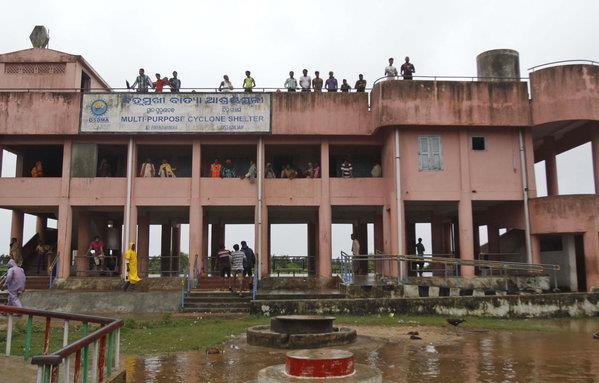October 12, 2013
ICHAPURAM/BHUBANESWAR: Rain and wind lashed India's east coast on Saturday, forcing about 450,000 people to flee to shelters as one of the country's largest cyclones closed in, threatening to cut a swathe of devastation through farmland and fishing hamlets.

October 12, 2013
ICHAPURAM/BHUBANESWAR: Rain and wind lashed India's east coast on Saturday, forcing about 450,000 people to flee to shelters as one of the country's largest cyclones closed in, threatening to cut a swathe of devastation through farmland and fishing hamlets.

Villagers take refuge in a cyclone shelter about 125 miles from the eastern Indian city Bhubaneswar. The cyclone was expected to affect 12 million people, most of them in the densely populated states of Odisha and Andhra Pradesh, officials said.
Filling most of the Bay of Bengal, Cyclone Phailin was about 90km (124 miles) off the coast by late afternoon and was expected to strike the coast by nightfall with winds of between 210kmph (130mph) and 220kmph (137mph).
The storm was expected to affect 12 million people, most of them in the densely populated states of Odisha and Andhra Pradesh, weather and disaster management officials said.
Even before landfall, coconut trees in villages along the coast were bent and broken in the gusting wind. Electrical poles were brought down and roads were littered with debris.
In the first reported deaths, two people were killed by falling trees while a third when the walls of her mud house collapsed.
Terrified children clung to their mothers as they sought shelter. Most towns along the coast were deserted but there were still some people trying to flee.
Some people took refuge in temples; others crammed into three-wheel auto-rickshaws and headed inland.
"This is one of the largest evacuations undertaken in India," said Shashidhar Reddy, vice chairman of the National Disaster Management Authority, who estimated that more than 440,000 people had fled from their homes.
The size of the storm made extensive damage to property more likely, he told reporters in New Delhi. "Our priority is to minimize loss of life."
Phailin is expected to bring a 3.4-metre (11-foot) surge in sea levels when it hits the coast between 1230 GMT and 1430 GMT.
Extensive damage
The weather department warned of extensive damage to mud houses, major disruption of power and communication lines, and the flooding of rail tracks and roads. Flying debris is another threat.
"In a storm of this magnitude there is the potential for widespread damage to crops and livestock in the low-lying coastal areas and houses completely wiped away," said Kunal Shah, the head of the aid group World Vision's emergency response team in India.
"While we are praying this storm loses intensity, we're also preparing."
London-based Tropical Storm Risk classed the storm in Category 5 – the strongest such rating. The US navy's weather service said wind at sea was gusting at 314kmph.
Many of the people along the coast are subsistence fishermen and farmers, who live in mud-and-brick or thatched huts.
In 1999, a typhoon battered the same region, killing 10,000 people.
India's disaster preparations have improved significantly since then and aid workers praised precautions for Phailin such as early warnings, stocking of rations in shelters and evacuations.
"A lot has been learnt since 1999 and my guess is that while there could be extensive damage to property and crops, the death toll will be much less," said G. Padmanabhan, emergency analyst at the U.N. Development Programme.
But despite all the warnings, some people refused to leave their homes.
"I have a small child, so I thought, how will I leave?" asked Achamma, 25, as she clutched on to her boy in Donkuru, a fishing village in Andhra Pradesh, as waves crashed on to a nearby beach.
Police said a rescue had been launched for 18 fishermen stranded at sea off Paradip, a major port in Odisha, after their trawler ran out of fuel.
Paradip halted cargo operations on Friday. All vessels were ordered to leave the port, which handles coal, crude oil and iron ore. An oil tanker holding about 2 million barrels of oil, worth $220 million, was also moved, an oil company source said.
However, the storm was not expected to hit India's largest gas field, the D6 natural gas block in the Cauvery Basin further down the east coast, field operator Reliance Industries said.
Courtesy: Reuters
















































































































